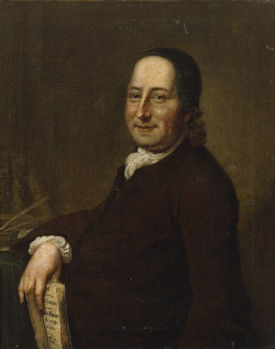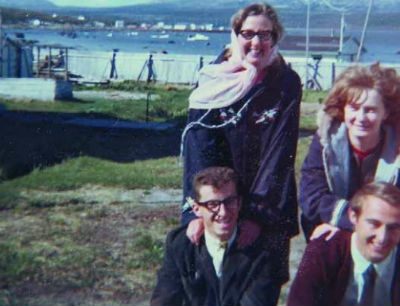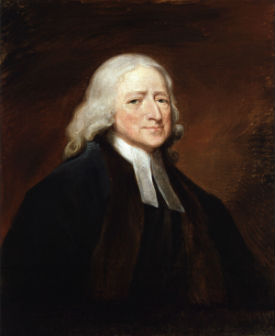How the ‘Peace Germans’ Changed America
By Neil Earle
“One quality nearly all these groups had in common – their willingness to bear peaceably with faiths other than their own…enriched our heritage, and redeemed our tarnished humanity.”
– Will Durant, The Story of Civilization (6), page 402.
 Count Nikolas Ludwig von Zinzendorf (1700-1760)
Count Nikolas Ludwig von Zinzendorf (1700-1760)In the early 1700’s a young nobleman from Saxony stopped to rest his horses in Dusseldorf. He was on his way to complete his studies in Paris.
In the interval, the young man visited Dusseldorf’s Town Hall to review the collection of paintings. His groomsmen found him, much later that evening, transfixed before a large painting titled “Christ Crowned with Thorns.”
Underneath was written: “This have I done for thee/What hast thou done for Me?”
It was a decisive moment. The young nobleman turned his coach round and headed back to his estate. “A new motive – to give, not to get – had become the impulse which dominated his life,” wrote Wilfrid Grenfell.
The rich young ruler’s name was Count Nikolas Ludwig von Zinzendorf (1700-1760) and one of his first actions as a converted Christian was to give shelter to a group on his estate called the Bohemian Brethren. These scattered and persecuted believers were refugees from Moravia where they were known as United Brothers (Unitas Fratrum). They would be reorganized and revitalized under Zinzendorf as the Moravians. Their influence on Germany and on the development of Christianity, especially in the newly evolving American colonies, would be vast.
As immigrants to America, associated but not identical with, other groups – the Menonnites, the Amish, the Brethren, Dunkers – they are together often designated by American historians as “the Peace Germans.”
This, in brief, is their fascinating story.
A Dying Church
Ever since Luther’s tumultuous Reformation of the Catholic Church in Europe there had been small scattered bands of Christian believers trying to find a more heart-felt, less political expression of personal holiness. The German churches had fallen from the high ideals of the first reformers. The destructive Thirty Years War (1618-1648) between Catholics and Protestants had given religion a bad name. Faith was seriously undermined. People slept openly in church; ministers argued hair-splitting points of doctrine; church-goers quarreled, swore and drank on the church steps; sermons were either frivolous and irrelevant or dead, cold and much too academic.
There were calls for revival – “to reform the Reformation.” Pastor John Arndt (1555-1621) had written an influential devotional tract called True Christianity which pleaded for “the actual practice of faith and godliness.” Arndt influenced the Alsatian pastor Philip Jacob Spener whose life and writings – especially Pia Desideria (Pious Desires) in 1675 – did much to shake the complacency of the established church. Spener advocated “a religion of the heart as well as the head” and is usually considered the founder of a movement known as Pietism. It called for a more extensive use of the Word in preaching, the need to reactivate the ministry of all believers, fervent love among the saints, better-trained preachers giving better sermons, and the toning down of theological disputations (Pia Desideria, pages 87-122).
Revival!
These sparks fell on the dry tinder of a heart-hungry population. Before his death, in 1705, Spener was a famous pastor and a sponsor at the baptism of Count Zinzendorf. The torch was passed. Just as the lamp of faith seemed near to being extinguished, a renewal of the German churches seemed possible. Zinzendorf himself left government service in 1727 to become a lay preacher and evangelist. He was formally ordained a bishop in 1737 after opposition from more orthodox Lutherans and immediately launched a program of overseas missionary work.
“In numerous trips to other lands, including two visits to America, he founded and nurtured churches and kindled a missionary vision hitherto unknown in Protestantism,” writes R.V. Pierard. “He also wrote hymns and prayers, created liturgical forms, and prepared daily ‘watch words’ (Losungen) to foster spiritual growth” (Evangelical Dictionary of Theology, page 1199). The beautiful Munster hymn, “Fairest Lord Jesus” from 1677, admirably enshrines that heartfelt fervency animating many German Christians:
Fair are the meadows, fairer still the woodlands,
Robed in the blooming garb of spring.
Jesus is fairer, Jesus is purer,
Who makes the woeful heart to sing.
As well as an intense form of “heart religion,” the Moravians called for a strong emphasis on community life – small groups, frequent worship services, spiritual directors and the use of choral and instrumental music. In this emphasis on the godly community, the Moravians were similar to but distinct from two other groups that sprang out of the Reformation – the Mennonites and the Brethren.
 Neil Earle, lower right, taught a summer at the Moravian Mission
school in Makkovik, Labrador in 1967 with the other staff.
Neil Earle, lower right, taught a summer at the Moravian Mission
school in Makkovik, Labrador in 1967 with the other staff.The Mennonites derived their name from Menno Simon (1496-1561) who took the lead of a group of Anabaptists (“Weider-taufer” – so named for their stress on re-baptism or the baptism of adults) whose distinctive doctrines included rejection of war and a principled call to Christian service. Menno pastored in the Netherlands, the Rhineland and Danish Holstein, holding to the apostle’s creed but differing with other Protestants on some fine points about the incarnation. In 1693 the Swiss elder Jakob Ammann, founded the Amish branch of the Mennonites in Alsace. Like the Mennonites, the Amish kept to themselves but did not officially live in communes. Nor did another related branch, the Church of the Brethren, motivated by five men and three women in Schwarzenau, Germany who later removed lock, stock and barrel to North America between 1719 and 1729 (Mead and Hill, Handbook of Denominations in the United States, page 147).
In Christian history, good things often come in small groups.
Spreading Branches
These “peace Germans” – Moravians, Mennonites, Brethren and Amish – by no means alike in every particular but determined to live apart from a corrupt world and in service to their fellows were shining a bright light. Many in Europe seeking a more pure form of Christianity began to look their way. One restless English seeker named John Smyth (1565-1612) moved to Holland to commune with the Mennonites. In 1609 Smyth established the first English Baptist church. The grassroots belief system that helped undergird the American Revolution, especially “that magistrates should not be given power over church affairs,” was a Baptist credo stemming from ideas the persecuted “peace Germans” had been advocating on the continent for decades (Noll, A History of Christianity in the United States and Canada, page 56).
When Roger Williams (1603-1683) established the first Baptist Church in America in Rhode Island, he dedicated the colony to religious toleration and the strict separation of church and state. These ideas would go straight into the Constitution of the United States. The Peace Germans had sown seeds that were sprouting further than they knew.
 John Wesley
John WesleyThe Missionary Spirit
It was only natural then that when the Quaker leader William Penn established his “holy experiment” at Pennsylvania that he would invite many who shared his belief in nonviolence and holy living. Very soon the Quakers and German Mennonite immigrants around the aptly-named Germantown, Pennsylvania were among the first to speak out against the institution of slavery. “There is a saying that we should do to men like as we will be done to ourselves,” they argued.
By 1735 the Moravians were moving in force to the New World. Seigfried Hettasch, the Moravian missionary to Makkovik, Labrador in the 1960’s, never tired of relating to the author the account of how the legendary evangelist John Wesley, on his way to a mission in Georgia, was convicted by Moravian piety when a severe storm buffeted their little ship in mid-Atlantic. This was true. In Will Durant’s words, “they rivaled the tempest winds with their sturdy hymns; the Wesleys felt that this was a faith stronger than their own” (The Story of Civilization, Volume IX, page 130). Not only that, but it was at a Moravian service in London on May 24, 1738 that Wesley felt his “heart strangely warmed.” Real conversion! That summer Wesley studied at Herrnhut, the Saxony village where Zinzendorf had settled his Moravian Brethren. John Wesley’s Methodists and the Baptist circuit riders were the primary “upstart sects” that would “conquer America” from 1775 to 1850, according to Stark and Fink’s The Churching of America.
Meanwhile, Moravian missionaries led by David Zeisberger (1721-1808) were bringing the Gospel to Native Americans. Zeisberger began his work among the fierce Iroquois of Pennsylvania’s Wyoming Valley, settling them into peaceful, productive villages. He next converted certain Delaware tribes to pacifism and resettled them at Freidenshutten (“Sheltered by Peace”) on the Susquehanna River. Persecution from warring groups was constant and they eventually moved from Ohio into Canada to a town called Gnadenhutten (“Shielded by Grace”), Ontario.
The more settled Amish had fanned out across Bucks and Lancaster Counties in Pennsylvania where the largest numbers remain. Their commitment to simplicity marks them still. “There are no Amish church buildings, no religious icons other than the Bible (an edition originally translated into German by Martin Luther), no special Amish creed aside from following Christ’s example,” writes Carol Highsmith and Ted Landphair. “Services are held every other Sunday in each other’s homes…Home worship harks back to the days when persecuted Anabaptists were forced to worship secretly. No fancy sanctuary or paid clergy is needed for communication with God” (The Amish, pages 8-9).
Historian Edward Ayers says of this period that “cultural exchanges between the Germans and English enriched American society” (American Passages, page 111). The list is huge, ranging from organ music, printing presses, decorative arts, house ornaments and architecture, “big barns,” pewter dishes, bulk stoves to a round of lesser delights from strudel to pastry to “coffee klatches.” Above all, the stress on literacy and education in order to read the Bible and works by Arndt and Spener inevitably strengthened American learning and letters. More importantly was the power of example. As the new country begin to fill up in the 1700’s, the Peace Germans in the “keystone Colony” of Pennsylvania were in a unique position to advance and strengthen such American notions as religious toleration, ethnic diversity, the separation of church and state and a developed philosophy of peace-making, diplomacy and social activism as opposed to the war option. Even today those churches both in Canada and the United States provide the proportionately largest relief and service organizations.
“We challenge the structures of this society,” writes spokesman John Howard Yoder,” not just because they ought to be challenged, but because it is Jesus Christ we proclaim.” The tradition of Spener and Zinzendorf lives on – the sense that, yes, you can make a better world, that salvation is not just personal but communal and affects our everyday lives.
Not all is perfect, of course. A tendency toward exclusivism or to be too disengaged in politics have been traditionally raised against these groups but, overall, by keeping the Christian peace option alive those early settlers wove a strong Gospel strand into the fabric of the American quilt. They not only “secured the backcountry” by the sweat of their brow, they gave a new nation alternative ways of thinking about the future, helped engender a hopeful vision that has beckoned to immigrants ever since.
Neil Earle is a Memphis-based pastor and journalist who taught school for the Moravian Mission in Makkovik, Labrador, Canada in 1967.